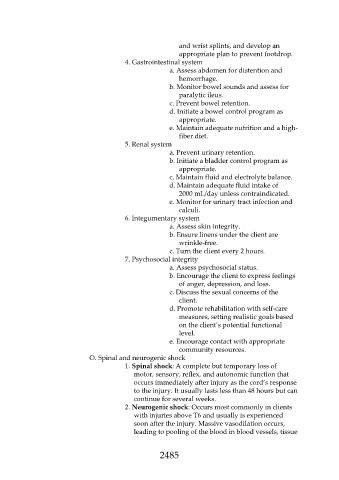Page 2485 - Saunders Comprehensive Review For NCLEX-RN
P. 2485
and wrist splints, and develop an
appropriate plan to prevent footdrop.
4. Gastrointestinal system
a. Assess abdomen for distention and
hemorrhage.
b. Monitor bowel sounds and assess for
paralytic ileus.
c. Prevent bowel retention.
d. Initiate a bowel control program as
appropriate.
e. Maintain adequate nutrition and a high-
fiber diet.
5. Renal system
a. Prevent urinary retention.
b. Initiate a bladder control program as
appropriate.
c. Maintain fluid and electrolyte balance.
d. Maintain adequate fluid intake of
2000 mL/day unless contraindicated.
e. Monitor for urinary tract infection and
calculi.
6. Integumentary system
a. Assess skin integrity.
b. Ensure linens under the client are
wrinkle-free.
c. Turn the client every 2 hours.
7. Psychosocial integrity
a. Assess psychosocial status.
b. Encourage the client to express feelings
of anger, depression, and loss.
c. Discuss the sexual concerns of the
client.
d. Promote rehabilitation with self-care
measures, setting realistic goals based
on the client’s potential functional
level.
e. Encourage contact with appropriate
community resources.
O. Spinal and neurogenic shock
1. Spinal shock: A complete but temporary loss of
motor, sensory, reflex, and autonomic function that
occurs immediately after injury as the cord’s response
to the injury. It usually lasts less than 48 hours but can
continue for several weeks.
2. Neurogenic shock: Occurs most commonly in clients
with injuries above T6 and usually is experienced
soon after the injury. Massive vasodilation occurs,
leading to pooling of the blood in blood vessels, tissue
2485

